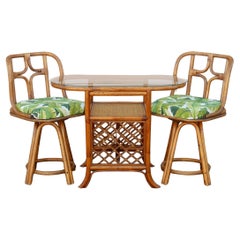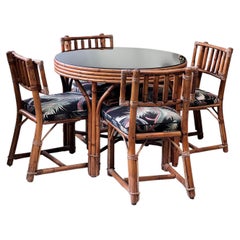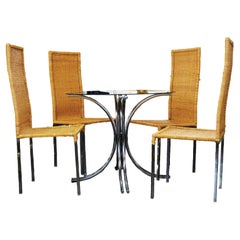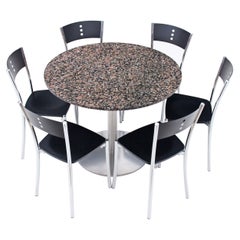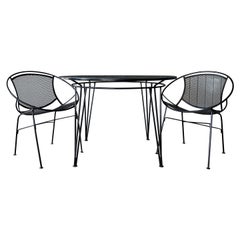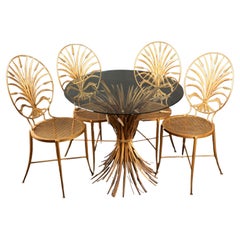Vintage Bistro Table and Chairs
to
7
45
9
54
36
11
10
6
5
3
3
3
2
2
2
1
1
Sort By
MOD Italian Progetti Memphis Style Bistro Table and Chair Set
By Progetti
Located in Los Angeles, CA
MOD Italian Memphis Progetti bistro table and chair set. A unique, modern style table set perfect
Category
1980s Italian Post-Modern Vintage Bistro Table and Chairs
Materials
Metal, Aluminum
$2,250 / set
H 28.5 in W 21.63 in D 21.63 in
Vintage Rattan & Cane Bistro Table and Chair Honeymoon Set
Located in Las Vegas, NV
glass top table and two swivel chairs. Elegantly crafted by Asian artisans of bend cane and reed.
This
Category
1970s Indonesian Hollywood Regency Vintage Bistro Table and Chairs
Materials
Upholstery, Cane, Rattan
$1,920 Sale Price
20% Off
H 29.5 in W 40 in D 20.75 in
Vintage French Garden Table Set Folding Metal Chair
Located in Chula Vista, CA
For your consideration, Vintage French Metal Folding Garden Patio Bistro Table and Chair Set
Category
Mid-20th Century French Mid-Century Modern Vintage Bistro Table and Chairs
Materials
Metal
1980s Rattan Bistro Table and Upholstered Chairs With Black Glass Top - Set of 5
Located in West Hollywood, CA
Vintage Rattan Bistro Set – a fusion of timeless allure and contemporary elegance. This
Category
1980s Unknown Bohemian Vintage Bistro Table and Chairs
Materials
Upholstery, Rattan, Glass, Wood
$2,168 Sale Price / set
26% Off
H 29 in Dm 36 in
Chrome and Glass Mid-Century Bistro Table and 4 Woven Rattan Chairs
Located in Chicago, IL
A mid-century modern bistro table with a chrome base and smoke glass top (that is 36" round). The
Category
1960s American Mid-Century Modern Vintage Bistro Table and Chairs
Materials
Chrome
$1,250 / set
H 29.5 in W 36 in D 36 in
Retro vintage granite table and 6 chrome black dining bistro kitchen chairs
Located in Wisbech, Cambridgeshire
Retro vintage granite table and 6 chrome black dining bistro kitchen chairs.
Late 20th Century
Category
20th Century Vintage Bistro Table and Chairs
Materials
Marble
$1,145 Sale Price / set
30% Off
H 29.93 in Dm 39.38 in
1960s iron Salterini outdoor bistro dining set, table and two chairs
By Salterini, Maurizio Tempestini
Located in Phoenix, AZ
Wrought iron patio Salterini “Radar” Collection bistro set with two hoop dining height chairs and a
Category
1960s Italian Mid-Century Modern Vintage Bistro Table and Chairs
Materials
Wrought Iron
Large French Bistro Table & Chairs Patio Set
Located in Staffordshire, GB
circa 1940
Large French Bistro Table & Chairs Patio Set
sku 1846
Table W97 x D97 x H72 cm
Weight 12
Category
20th Century Vintage Bistro Table and Chairs
Materials
Iron
1960s Italian Wheat Back Chairs with Original Bistro Table by S. Salvadori
By S. Salvadori
Located in New York, NY
backs resembling a sheaf of wheat, accompanied by the original bistro table. Elegantly poised on slender
Category
Mid-20th Century American Mid-Century Modern Vintage Bistro Table and Chairs
Materials
Metal
$4,200
H 50 in W 50 in D 50 in
Bistro 1900
By Liudmila Kondakova
Located in Greenwich, CT
-filled courtyard. The bistro door opened invitingly, with table and chairs set out on a balmy spring
Category
20th Century Contemporary Vintage Bistro Table and Chairs
Materials
Paper, Screen
3 pc. Mid Century Dinette Kitchen Cafe Bistro Set after Paul McCobb c. 1950/60's
By Paul McCobb
Located in New York, NY
Classic Mid Century Dinette, Kitchen, Bistro, Cafe style table and chair set, including two chairs
Category
Mid-20th Century American Mid-Century Modern Vintage Bistro Table and Chairs
Materials
Metal
$695
H 28.5 in Dm 24 in
Wonderful Brass and Copper Wall Sculpture of an Outdoor Cafe by Curtis Jere
By Curtis Jeré
Located in Mount Penn, PA
to detail that includes: bistro tables and chairs, umbrellas, trees and arched windows. In great
Category
Late 20th Century American Post-Modern Vintage Bistro Table and Chairs
Materials
Brass, Copper
$2,800
H 46 in W 18 in D 5 in
Set of Pair of Three-Leg Chairs and Bistro Table
Located in Porto, PT
Set of two three-leg chairs and bistro table from with black painted metal frames and wooden parts.
Category
1980s European Industrial Vintage Bistro Table and Chairs
Materials
Iron
Vintage Bistro Table and Chairs
Located in North Miami, FL
Extremely well crafted garden or kitchen set in forest green patina.
Category
1960s American Vintage Bistro Table and Chairs
Materials
Glass
Cast Iron and Brass Bistro Table and Chairs
Located in Hudson, NY
The table is probably a decade older than the chairs.It is of a much heavier gage metal and the
Category
20th Century Unknown Vintage Bistro Table and Chairs
Materials
Iron, Brass
Vintage Bamboo and Rattan French Bistro Table and Chairs
Located in Palm Beach, FL
Transporting mid century French bistro round table and four chairs crafted in bamboo with rattan
Category
Mid-20th Century French Edwardian Vintage Bistro Table and Chairs
Materials
Bamboo, Rattan, Paint
Mid-20th Century Bent Ply Wood Bistro Table and Chair Set
Located in London, GB
A rare and unusual mid-20th century bent plywood table with two chairs.
We are unsure of
Category
Mid-20th Century European Mid-Century Modern Vintage Bistro Table and Chairs
Materials
Plywood
Superb Plantation or Bistro Set of 4 Cane and Bentwood Armchairs and Table
Located in Godshill, Isle of Wight
Superb plantation or bistro set of 4 cane and bentwood armchairs and table
The round table is
Category
1960s Colonial Revival Vintage Bistro Table and Chairs
Materials
Cane
$4,657
H 40 in W 25 in D 28 in
Midcentury French Brass Bistro Set with Black Marble-Top Table and Four Chairs
Located in Fayetteville, AR
circular table with a black marble top and four chairs upholstered in black skai. The set rests on footed
Category
Mid-20th Century French Mid-Century Modern Vintage Bistro Table and Chairs
Materials
Marble, Brass
$4,500 / set
H 30 in Dm 19.75 in
c.1950 French Bistro Table Paired w/ Bamboo Chairs
Located in Chicago, IL
Vintage French iron bistro table that has a top with the look of marble but it is not stone with a
Category
1950s French Vintage Bistro Table and Chairs
Materials
Iron, Brass
Mid-Century Modern Burke Pair of Black Propeller Side Chairs and Bistro Table
By Burke, Inc.
Located in Keego Harbor, MI
For your consideration is a phenomenal bistro set, including a rectangular table and pair of
Category
1960s Mid-Century Modern Vintage Bistro Table and Chairs
Materials
Metal
$975 / set
H 26 in W 24 in D 36 in
Memphis Style Bistro Table & 2 Chairs Hand Painted Multi Color 1980 Modern
Located in Keego Harbor, MI
Vibrant and fun, this hand painted bistro set includes the table and two chairs and is in very good
Category
1980s Vintage Bistro Table and Chairs
Materials
Iron
$1,600 / set
H 30 in Dm 24 in
1930's Original Cast Base Fischel Bistro Dining Table '1486'
Located in Hook, Hampshire
1930's Original cast base Fischel Bistro dining table (1486)
1930's Original cast base Fischel
Category
1930s Vintage Bistro Table and Chairs
Materials
Cast Stone
Weird and Quirky Bistro Garden Table and Chairs
Located in Godshill, Isle of Wight
Weird and Quirky Bistro Garden Table and Chairs
Weird and Quirky Bistro Garden Table and Chairs
Category
1960s Steampunk Vintage Bistro Table and Chairs
Materials
Iron
Charming Vintage French Bistro Dining Table and Chairs
Located in Hopewell, NJ
Classic vintage French cafe set having a round iron table and set of 6 matching chairs. Chairs are
Category
1950s French Vintage Bistro Table and Chairs
Materials
Metal
Arthur Umanoff Shaver Howard Bistro Table and Two Chairs
By Arthur Umanoff
Located in Ferndale, MI
table top with glass overlay. The two scroll arm chairs have raffia wrapped circular backs and round
Category
Mid-20th Century American Mid-Century Modern Vintage Bistro Table and Chairs
Materials
Wrought Iron
Listers Luytens Teak Garden Table and Chairs Bistro Set Tea for Two Bistro Set A
Located in Stow on the Wold, GB
, comprises two chairs and a table. The set very cleverly slots together when not in use therefore taking up
Category
20th Century English Mid-Century Modern Vintage Bistro Table and Chairs
Materials
Steel
$1,301
H 28.75 in W 23.63 in D 23.63 in
Vintage Woodard Round Dining Table and Set of 5 Bistro Chairs
By Woodard Furniture Co.
Located in Hopewell, NJ
Classic patio dining table and chairs by Woodard having round table with center pedestal and pretty
Category
1940s American Vintage Bistro Table and Chairs
Materials
Iron
Listers Luytens Teak Tea for Two Bistro Set Atlantis Garden Table and Chairs
Located in Stow on the Wold, GB
, comprises two chairs and a table. The set very cleverly slots together when not in use therefore taking up
Category
20th Century English Mid-Century Modern Vintage Bistro Table and Chairs
Materials
Steel
$1,438
H 28.75 in W 23.63 in L 28.75 in
Vintage Plantation Patterns Iron Daisy Flower Bistro Dining Set 4 Chairs Table
Located in Philadelphia, PA
glass top table, (4) dining side chairs, flower pot with faux flowers, yellow vinyl cushions, daisy and
Category
Mid-20th Century North American Mid-Century Modern Vintage Bistro Table and Chairs
Materials
Wrought Iron
$995 / set
H 32 in W 17.5 in L 32 in
French Metal Bistro Table and Chairs
Located in New York, NY
Vintage French metal bistro table and chairs in green folding metal with wood slatted seats, France
Category
Mid-20th Century French Vintage Bistro Table and Chairs
Materials
Metal
Darling Vintage Outdoor Bistro Table and Chairs
Located in Hopewell, NJ
Charming outdoor table and two chairs painted a soft green. Each chair has a darling bird resting
Category
1970s American Vintage Bistro Table and Chairs
Materials
Metal
Turquoise Salterini Painted Iron Bistro Table and Chairs, Mid-Century Modern
By John Salterini
Located in Haddonfield, NJ
Mid-Century Modern turquoise powder-coated metal Salterini bistro table and 2 chairs set.
The
Category
1940s American Mid-Century Modern Vintage Bistro Table and Chairs
Materials
Iron
$1,650
H 32 in W 21 in D 16 in
Vintage MCM Arthur Umanoff for Shaver Howard Style Bistro Table & 2 Chairs
By Arthur Umanoff
Located in Chicago, IL
Vintage Mid Century Modern Arthur Umanoff for Shaver Howard Bistro Table and Two Chairs
This
Category
Mid-20th Century American Rustic Vintage Bistro Table and Chairs
Materials
Wrought Iron
$1,599
H 32.5 in W 22.5 in D 22 in
"Provence", South of France Cafe, Bistro Table & Chairs Drypoint Etching
By Judith Gaulke
Located in Soquel, CA
Charming etching of a bistro table and chairs at an outdoor cafe in Provence, south of France by
Category
Late 20th Century American Impressionist Vintage Bistro Table and Chairs
Materials
Paper, Ink, Drypoint, Etching
$375
H 14.5 in W 11.5 in D 0.07 in
Depression Era Bentwood Cafe Bistro Table and Four Chairs
By Thonet
Located in Las Vegas, NV
Dated 1937 set of four bentwood cafe bistro chairs and table.
In the style of Thonet this is a
Category
1930s Late Victorian Vintage Bistro Table and Chairs
Materials
Wood
Vintage Russell Woodard Spun Fiberglass Patio Bistro Set, Table and Chairs
By Russell Woodard
Located in Atlanta, GA
in excellent condition. The set includes a dining table with original glass top and four chairs with
Category
1960s American Mid-Century Modern Vintage Bistro Table and Chairs
Materials
Glass, Fiberglass
French Rattan Bistro Table & Chairs
Located in Stamford, CT
Rattan and reed woven French Bistro set, two chairs and table. A fanciful curvy bistro set made up
Category
Mid-20th Century French Vintage Bistro Table and Chairs
Materials
Rattan, Reed
French Bistro Cafe Folding Metal Table and Matching Chairs
Located in Sheffield, MA
French cafe round bistro table with a pair of matching chairs are perfect for the porch, patio or
Category
1950s French Napoleon III Vintage Bistro Table and Chairs
Materials
Iron
Woodard Iron Patio/Outdoor Table & Chairs Bistro Patio Set
By Russell Woodard
Located in Van Nuys, CA
Mid-century Iron Bistro outdoor/patio set includes both tables with chairs, a distinct scrolling
Category
1950s Vintage Bistro Table and Chairs
Materials
Iron
Vintage French Hand-Forged Patinated Metal Bird Bistro Glass Top Table and Chair
Located in Chicago, IL
Vintage French Hand-Forged Patinated Metal Bird Bistro Glass Top Table and Chairs - 3 Piece Set
Category
1960s French Bohemian Vintage Bistro Table and Chairs
Materials
Metal
$3,750
H 39.5 in W 17 in D 17.5 in
Pair of French style fold up bistro chairs with table
Located in Ferndale, MI
Two French style bistro chairs with compact table ( 10.5 x 11 at 24.5 tall ) . Welded steel frames
Category
Mid-20th Century American Mid-Century Modern Vintage Bistro Table and Chairs
Materials
Steel
French Bistro 5 Piece Set, 4 Folding Slatted Chairs with an Iron Table
Located in Port Jervis, NY
Shabby chic outdoor cafe bistro 5 piece set of iron and Slatted wood chairs and a 24 diameter metal
Category
1970s American Country Vintage Bistro Table and Chairs
Materials
Iron
3 Pc. Salterini Orange Slice Clam Shell Bistro Patio Dining Table & Chairs Set
By John Salterini, Maurizio Tempestini
Located in West Palm Beach, FL
Mid Century Modern 3 Piece bistro dining table set & 2 chairs. Design by Maurizio Tempestini for
Category
1950s American Mid-Century Modern Vintage Bistro Table and Chairs
Materials
Wrought Iron
$4,200
H 28.5 in W 23 in D 19.5 in
Vintage 3 pc. Metal Cafe Bistro Set by Carolina Forge Table with Two Chairs
By Woodard Furniture Co., Salterini
Located in New York, NY
Chic cafe, bistro, patio, garden, or poolside set consisting of two side chairs, and one table
Category
Mid-20th Century American Mid-Century Modern Vintage Bistro Table and Chairs
Materials
Metal, Brass, Wrought Iron
$595
H 29 in W 28 in D 28 in
Woodard Mid-Century, 1950-1950, Bistro Set
By Woodard Furniture Co.
Located in Bellport, NY
A Mid-Century Woodard bistro set.
Table and four chairs, Indoor outdoor.
The table measurements
Category
Mid-20th Century American Mid-Century Modern Vintage Bistro Table and Chairs
Materials
Metal
Bistro Table and Chairs
Located in Spokane, WA
Unique bistro set with japanned metal finish. Traditional Quarter sawn oak top combined with
Category
20th Century American Vintage Bistro Table and Chairs
Materials
Steel
Lucite Bistro Table and Chairs
Located in Stamford, CT
High Lucite Bistro with 2 matching chairs
Category
1980s Vintage Bistro Table and Chairs
Antique French Bistro Table and Chairs
Located in Charleston, SC
This rectangular marble top table has "GODIN" cast iron feet and wrought iron structure.Its size is
Category
1940s French Vintage Bistro Table and Chairs
Materials
Marble, Iron
Faux Crocodile French Bistro Table and Two Chairs
Located in Los Angeles, CA
Outstanding Faux Stiched Leather Campaign Table and 2 Chairs. Both the Table and 2 Chairs collapse
Category
1960s French Vintage Bistro Table and Chairs
Materials
Metal
C. 1950 Teak and Iron Folding Bistro Table and Four Chairs
Located in Los Angeles, CA
C. 1950 French teak and black iron folding bistro table and four chairs. This is a terrific looking
Category
1950s French Vintage Bistro Table and Chairs
Materials
Iron
Italian Marble Topped Bistro Table With Two Chairs
Located in Chicago, IL
An Italian Marble Topped Bistro Table. The Chairs have Brass Finials and Mesh Seats. The Chair
Category
1960s Italian Vintage Bistro Table and Chairs
Materials
Marble, Iron, Brass
Industrial Bistro Table and Chair Set
Located in Bridport, CT
Super chic Industrial, octagonal shaped metal table. One of a kind with two matching chairs and
Category
1930s Unknown Industrial Vintage Bistro Table and Chairs
Materials
Steel
Bon Appétit! French Teak Bistro Indoor/Outdoor Folding Table and Chairs
Located in Westport, CT
Bon appétit! French teak bistro indoor/outdoor folding table and chairs. Great removable red
Category
Late 20th Century Unknown Mid-Century Modern Vintage Bistro Table and Chairs
$595
H 28.5 in W 27.5 in D 27.5 in
Get Updated with New Arrivals
Save "Vintage Bistro Table And Chairs", and we’ll notify you when there are new listings in this category.
Vintage Bistro Table And Chairs For Sale on 1stDibs
At 1stDibs, there are several options of vintage bistro table and chairs available for sale. Each of these unique vintage bistro table and chairs was constructed with extraordinary care, often using metal, iron and wood. Vintage bistro table and chairs have long been popular, with older editions for sale from the 20th Century and newer versions made as recently as the 20th Century. Vintage bistro table and chairs are generally popular furniture pieces, but Mid-Century Modern, Industrial and Victorian styles are often sought at 1stDibs. Burke, Inc., Russell Woodard and Woodard Furniture Co. each produced beautiful vintage bistro table and chairs that are worth considering.
How Much are Vintage Bistro Table And Chairs?
The average selling price for at 1stDibs is $1,725, while they’re typically $375 on the low end and $5,800 highest priced.
More Ways To Browse
Molla Table
Umanoff Granada
Wine Bottle Holder 7 Bottles
Folding Metal Bistro Table
Pink Bistro Table
Salterini Peacock Chairs
Salterini Peacock
Arthur Umanoff Outdoor
Russell Woodard 5 Piece Patio Set
Salterini Ribbon Chairs
Arthur Umanoff Grenada
Bistro Rattan Black
Brooks Table Lamp
Enamel Bistro Table
French Folding Bistro Table
Iron Chairs Daisy
Lutyens Chair
Molla Chairs

